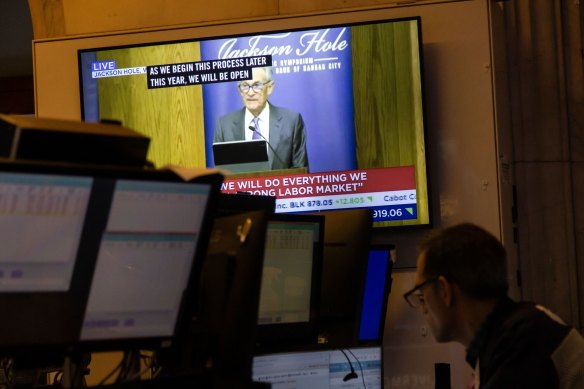
While Friday’s payroll data is expected to show a material improvement in job creation in August relative to July, along with a slight improvement in the unemployment rate, the growth in jobs over the past three months is expected to be the weakest in more than three years.
Last month, at the annual Jackson Hole gathering of central bankers, economists and other policymakers in Wyoming, the Fed’s chair Jerome Powell said “the time has come” for the Fed to start cutting rates, and made it clear the state of the jobs market will most influence the central bank’s decision-making.
“We do not seek or welcome further cooling in labour market conditions,” Powell said.

Fed chair Jerome Powell said that “the time has come” for the Fed to start cutting rates. By how much depends on the US jobs market.Credit: Bloomberg
The Fed’s monetary policy decision-making body, the Open Market Committee, holds its next meeting on the 17th and 18th of this month.
With its preferred measure of inflation, the Personal Consumption Expenditures Price Index, showing the US inflation rate has fallen to around 2.5 per cent – within sight of the Fed’s target of 2 per cent – it is almost inevitable that the central bank will announce a rate cut. The question is, by how much?
Loading
US financial markets are pricing in a full percentage point reduction in the federal funds rate by the end of the year, implying there will be one 50 basis point “jumbo” reduction at one of the three remaining meetings. If the jobs data disappoints again, that over-sized cut could come in a fortnight.
While conventionally that would be positive for the sharemarket, it could also be interpreted as a signal that the Fed has suddenly become fearful that it might have left rate cuts too late to stave off a recession, which wouldn’t be good news for financial markets or the real economy.
Investors’ fears are underscored by the fact that another full percentage point of rate reductions is priced in for next year.
If that eventuated, it would be one of the most aggressive shifts towards looser US monetary policy in decades. With the effective federal funds rate at about 5.3 per cent, the Fed has a lot of firepower up its sleeve.
The bond market was already heading in that direction. The yields on two-year US Treasury notes have fallen from just above 5 per cent in April to 3.86 per cent on Tuesday, and the yield on 10-year bonds from 4.7 per cent in April to 3.83 per cent.
While markets are always jumpy in September – historically, going as far back as the middle of the last century, it has been the worst-performing month of the year for stocks – there are good reasons for investors to be more conscious of risk in a sharemarket that’s still only 2.5 per cent of the record levels reached in July. Investors have implicitly priced in a soft landing for the economy.
It appears the US economy is slowing, but that’s occurring within a global economy where growth seems to be weakening.
As discussed on Tuesday, data on China’s economy released over the past few days shows activity within its key manufacturing base is continuing to contract, with contagious effects throughout the Asia Pacific. Europe’s economies are generating anaemic growth, at best.
The global weakness is reflected in what’s happened to key commodity prices.
Loading
The oil price hit a year low of $US73.60 a barrel on Tuesday and is now more than 19 per cent off its year-highs.
The copper price – regarded as a key barometer of global economic health – has fallen about 5 per cent over the past week and is just under 20 per cent off its year-high.
Those falls relate to weakening demand, not oversupply. Indeed, oil supply remains constrained by OPEC+ production cuts that - in theory at least (if not quite in practice) - have removed almost 6 million barrels a day from the global market.
When Wall Street was first gripped by fears last month that the Fed might have missed the moment to start cutting US interest rates, the sharemarket initially fell sharply but rebounded strongly.
That window of opportunity probably still exists, albeit narrower, and the Fed will have the option of jumping through it in less than a fortnight.
What the world’s key central bank says and does after this month’s meeting could determine the fate of the US economy, with implications for the global economy and financial markets.
It might also have some impact on the outcome of the US election and even the future governance of the Fed itself, both of which could have significant implications for the rest of the world.
The Business Briefing newsletter delivers major stories, exclusive coverage and expert opinion. Sign up to get it every weekday morning.









 Add Category
Add Category